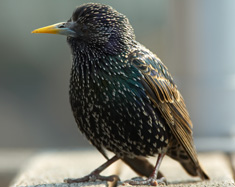Pest Library – Birds
Birds Removal & Control Services Toronto
As the Greater Toronto Area’s leading bird control specialists, City & Country Pest Control provides years of experience, offering the widest range of bird control services and techniques to tackle any bird-related problem. Unwanted birds can cause a number of serious problems for both residential and commercial property owners and the farming community. Residential issues can include nesting in dryer vents, eaves, and soffits; damaging siding; and leaving droppings on awnings, ledges, balconies, windows, and cars. Left unchecked, bird droppings on sidewalks can also lead to slips and falls.
Birds also carry parasites, allergens, bacteria, and other health risks, and can also be quite aggressive during their nesting season. Birds can also do untold damage to commercial buildings and properties. Bird droppings are very acidic and can eat away at many substances, including tar-based roofing and shingles, causing leaks. An accumulation of bird droppings has even caused the roof of a gas station to collapse.1
Wildlife damage to agricultural crops in Ontario is estimated to cost farmers over $40.0 million annually. Bird droppings and nesting materials can also block machinery and farming equipment, causing it to operate inefficiently, leading to expensive repairs.2
For more information about how City & Country Pest Control can assist you with bird control,
contact us at 905-455-1102 or info@cityandcountrypestcontrol.com.
English Sparrow
 Perhaps the world’s most common bird, the English sparrow, often referred to as the house sparrow, was introduced into North America in the mid-1800s in an effort to protect trees from a native caterpillar. Over the years, the sparrow has become one of the most common birds in the GTA.3
Perhaps the world’s most common bird, the English sparrow, often referred to as the house sparrow, was introduced into North America in the mid-1800s in an effort to protect trees from a native caterpillar. Over the years, the sparrow has become one of the most common birds in the GTA.3
About six inches long, these tiny birds have brown wings with white bars, a narrow white stripe over the eye, white and chestnut cheek patches, and a black throat and breast. Prolific breeders, a few house sparrows can quickly turn into a thousand in a few short years. Sparrows regularly raise three-five broods per year; with each one averaging around five or six birds.
Sparrows can be aggressive birds that force out other birds from their territories. Because they are flocking birds, sparrows can gather in the thousands to take over feeding and roosting areas.
Like many non-native birds, sparrows are not picky eaters. They like seeds, insects, buds, dandelions, berries, and fruit, but prefer to eat food provided – directly or indirectly – by humans. As a result, sparrows like areas that have been inhabited by people. They are much more common in an industrial park or on a city lawn than in a forest.
European Starling
 After two failed attempts, the European starling was successfully introduced into North America in 1890, when 100 were set free in New York City’s Central Park. A romantic notion gone wild, they were released by the Acclimation Society of North America in an effort to establish all the birds mentioned in Shakespeare’s works.4
After two failed attempts, the European starling was successfully introduced into North America in 1890, when 100 were set free in New York City’s Central Park. A romantic notion gone wild, they were released by the Acclimation Society of North America in an effort to establish all the birds mentioned in Shakespeare’s works.4
In 60 short years, the invading European starlings were able to spread their wings all the way to the Pacific; thriving on North American vegetation and usurping native species along the way.5
Today, over 200 million European starlings call North America home. Closer to home, over 255,000 European starlings, or half of Canada’s total wintering starling number, spend winter in the Golden Horseshoe area. Roughly two-thirds of Ontario’s starlings migrate south during the winter months; meaning that Ontario’s European starling breeding population is closing in on one million.
About the same size as a robin, European starlings can vary in colour depending on the season. In the fall and winter, the dull brown and black feathers of Ontario’s European starlings are covered with white spots that are really the tips of new feathers. In the spring, the feathers darken into a spot-less glossy black, with hints of green and purple.
Starlings eat a variety of foods, including fruits and seeds, insects, lawn grubs, and other invertebrates. During the cold winter months, starlings eat food in garbage. Starlings also consume large quantities of livestock rations; in doing so, the birds can contaminate the feed with their droppings.
Pigeon
 Considered the number one pest by most urban residents, feral pigeons – also called city doves, city pigeons, and street pigeons – have adapted to urban life and can be found in large numbers in every city across the country.
Considered the number one pest by most urban residents, feral pigeons – also called city doves, city pigeons, and street pigeons – have adapted to urban life and can be found in large numbers in every city across the country.
Descended from the rock dove, feral pigeons have a short neck, small head, and short legs that allow them to easily perch on branches and flat surfaces. While the most common colour of pigeon is blue-grey, they can also be black, brown, white, and even multicoloured (piebald).
The perfect pest, pigeons are not afraid of people; are at home in man-made structures, and will eat just about anything. Their preferred food is seeds, but they will also eat popcorn, bread, peanuts, etc. Like their domestic peers, pigeons mate for life, until one dies; the survivor then seeks another mate.6
Sources
- “Rain + pigeon poop = canopy collapse,” YumaSun December 28, 2008; http://www.yumasun.com/news/canopy-46598-collapse-pigeon.html.
- “Ontario Wildlife Crop Damage and Livestock Predation Assessment Manual,” Ontario Ministry of Natural Resources n.p.; http://www.ofah.org/downloads/getfile.php?id=PDF/e-OntarioWildlifeCropDamage.pdf.
- “General Information,” Doveline 2010; http://www.doveline.com/html/dove-information.html.
- Alison, Robert. “An ode to starlings, our most misunderstood bird,” Toronto Star January. 11, 2009; http://www.thestar.com/news/2009/01/11/an_ode_to_starlings_our_most_misunderstood_bird.html.
- “European Starlings,” Stanford University n.p.; http://www.stanford.edu/group/stanfordbirds/text/essays/European_Starlings.html.
- “The English Sparrow,” Birds December 1897; 2(6); http://www.birdnature.com/dec1897/sparrow.html.


